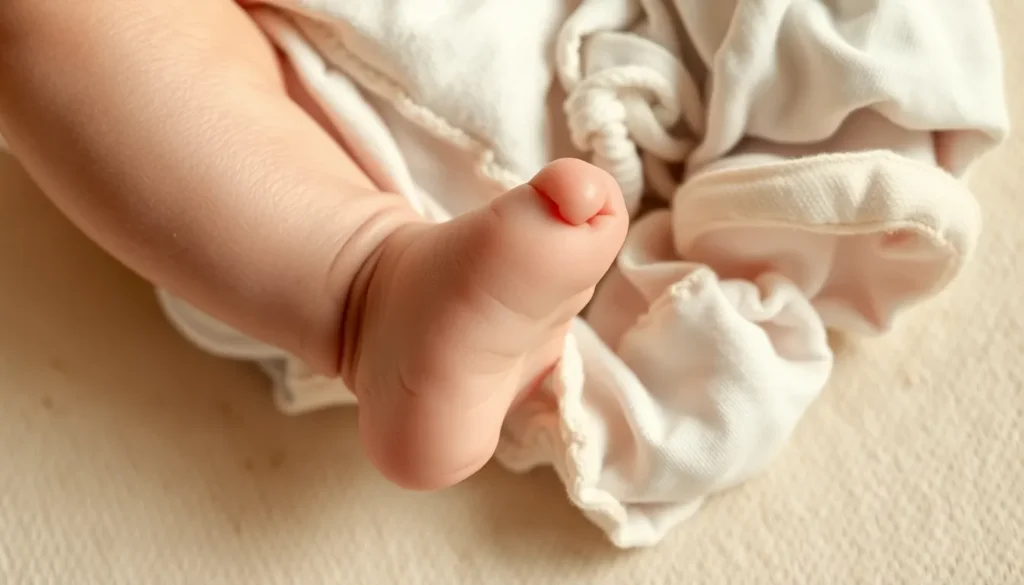Table of Contents
ToggleWhen a tiny human makes their grand entrance into the world, they come with a little something extra: the umbilical cord. This remarkable lifeline, while crucial during pregnancy, needs some TLC after birth. Proper umbilical cord care isn’t just about keeping things tidy; it’s about ensuring that new parents avoid potential hiccups in their baby’s health journey.
Overview of Umbilical Cord Care
Umbilical cord care is vital for preventing infections and promoting healing in newborns. Parents must understand why monitoring the site is crucial. Care begins immediately after birth, focusing on cleanliness and dryness. Keeping the area clean helps reduce the risk of complications.
The cord typically falls off within 1 to 3 weeks after delivery. During this time, it often changes color, becoming brown or black as it dries. This is a normal part of the healing process. New parents should avoid pulling on the cord, as doing so could cause bleeding.
When cleaning, use a cotton swab or clean cloth. Moisten the swab with water and gently clean around the base of the cord. Soap and water are sufficient, but some healthcare providers recommend avoiding alcohol due to potential irritation. Parents must observe for signs of infection, which may include redness, swelling, or discharge.
Air exposure accelerates cord drying; therefore, leaving the diaper folded below the cord can help. Parents should always check the cord site during diaper changes. It’s important to consult a pediatrician if unusual symptoms occur.
Education on proper umbilical cord care leads to better health outcomes for newborns. Awareness of common practices ensures parents support their child’s recovery effectively. Engaging with healthcare providers about care techniques reinforces confidence in monitoring the umbilical cord. A well-cared-for cord contributes to the overall well-being of the infant.
Importance of Umbilical Cord Care

Umbilical cord care plays a crucial role in ensuring newborns remain healthy. Attention to this area can prevent infections and promote proper healing.
Preventing Infections
Preventing infections requires diligent cleaning of the cord stump. Parents must keep the area dry and free from bacteria. Signs of infection include redness, swelling, or discharge. Therefore, monitoring is essential. Parents should wash their hands before touching the stump to reduce the risk of germs transferring. Gentle cleaning with a moistened cotton swab aids in removing any dried secretions. Notably, exposure to air supports drying, helping to minimize infection chances. When in doubt, consulting a pediatrician is advisable if any concerning symptoms arise.
Promoting Healing
Promoting healing involves maintaining cleanliness and proper care routines. Cord stumps typically fall off within 1 to 3 weeks, but this varies by newborn. Parents should avoid pulling on the stump, as this can irritate the skin and delay healing. Instead, they must allow the natural process to occur. Observing color changes in the stump is also important. A healthy stump shifts from yellow to brownish as it heals. Encouraging air exposure can enhance the healing process, allowing the stump to dry effectively. Continued communication with healthcare providers ensures any healing issues are addressed promptly.
Best Practices for Umbilical Cord Care
Proper umbilical cord care is crucial for the health of newborns. Parents can ensure better recovery and reduce infection risks by following best practices.
Keeping the Area Clean
Cleaning the umbilical cord stump plays a significant role in preventing infections. Parents must wash their hands thoroughly before handling the stump to limit germ transfer. Gentle cleaning with a moistened cotton swab or cloth removes dried secretions effectively. It’s important to avoid harsh cleansers or excessive rubbing. Assessing the area for signs of irritation, such as redness or swelling, helps in monitoring health. Every day, parents should keep the stump clean while being attentive to any changes in color. A well-maintained stump heals faster, promoting overall infant health.
Proper Drying Techniques
Drying the umbilical cord stump efficiently supports the healing process. Parents can encourage airflow by leaving the stump uncovered. Avoiding tight diapers or clothing against the stump allows for better air exposure. Using a loose-fitting diaper helps maintain dryness while preventing irritation. Patting the area gently after baths prevents moisture accumulation. Parents should assess the stump daily, noting color changes that indicate proper healing. Monitoring for any signs of infection remains essential throughout this process. By prioritizing drying techniques, parents can ensure a smoother recovery for their newborn.
Common Myths About Umbilical Cord Care
Several myths surround umbilical cord care, leading to confusion among new parents. Addressing these misconceptions clarifies best practices for maintaining newborn health.
Myth vs. Fact
The belief that umbilical cords must be kept completely covered is false. In reality, exposing the stump to air promotes drying and healing. Some think that cleaning the stump with alcohol is necessary, but pediatricians recommend using just mild soap and water instead. It’s also a myth that pulling on the cord speeds up its detachment; this can cause irritation and prolonged healing time. Many parents worry that a foul smell indicates an infection; however, a slight odor can be normal as the stump dries out. Observing the stump’s color does matter, as healthy stumps shift from yellowish to brownish without indicating problems. Understanding these facts supports effective cord care, enhancing the well-being of the newborn.
When to Seek Medical Attention
Parents should observe the umbilical cord stump closely for any signs of complications. Symptoms that warrant immediate medical attention include increased redness around the stump, which might indicate an infection. Swelling near the base of the cord or surrounding skin can also be a cause for concern.
Discharge that appears green, yellow, or has a foul odor signifies potential infection and requires prompt evaluation by a healthcare professional. Unusual bleeding from the stump site is another critical issue that needs addressing. If the stump hasn’t fallen off by three weeks or shows no signs of healing, consulting a pediatrician becomes essential.
Parents may notice a change in their baby’s behavior, such as excessive crying or irritability, which could reflect discomfort from an infected cord. Additionally, if an infant develops a fever exceeding 100.4°F (38°C), contacting a healthcare provider is necessary to rule out serious complications.
Communication remains a crucial aspect of umbilical cord care. Regular check-ups with a pediatrician provide reassurance and allow parents to address concerns regarding cord health. Understanding these signals helps ensure the baby receives timely care to promote healing and well-being. Regular monitoring leads to a positive outcome, keeping both parents and infants healthy.
Proper umbilical cord care is crucial for a newborn’s health and well-being. By following recommended practices such as keeping the area clean and dry and monitoring for signs of infection, parents can ensure a smooth healing process. Understanding the natural progression of the cord’s healing can alleviate concerns and foster confidence in new parents.
Open communication with healthcare providers further supports effective care and addresses any worries. With diligence and attention, parents can navigate this important aspect of newborn care, promoting a healthy start for their child.







